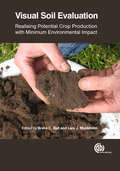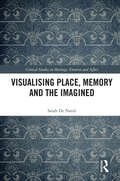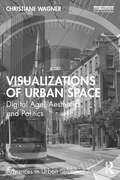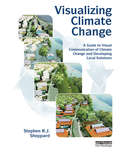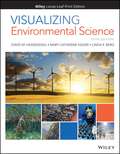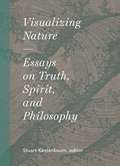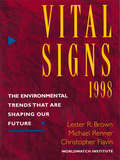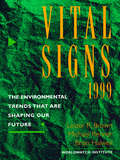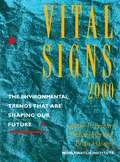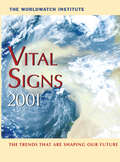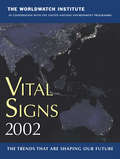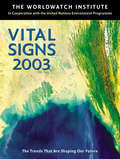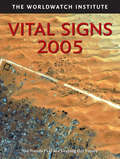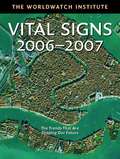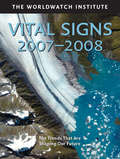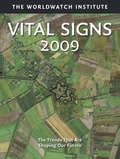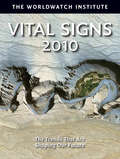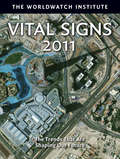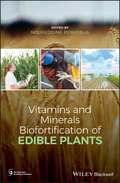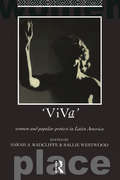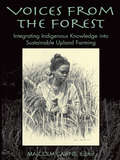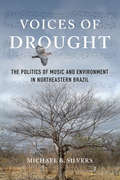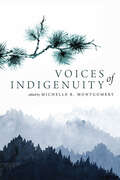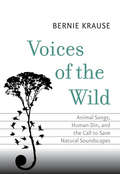- Table View
- List View
Visual Soil Evaluation
by Bruce C. Ball Rachel Guimarães Tom Batey Anne Weill Dick Godwin Lothar Mueller Mary Norton Scherbatskoy Joanna Cloy Lars J. MunkholmVisual Soil Evaluation (VSE) provides land users and environmental authorities with the tools to assess soil quality for crop performance. This book describes the assessment of the various structural conditions of soil, especially after quality degradation such as compaction, erosion or organic matter loss. Covering a broad range of land types from abandoned peats to prime arable land, this useful handbook assesses yield potential across a range of scales. It also appraises the use of VSE in determining the potential of different land types for carbon storage, greenhouse gas emissions and nutrient leaching, and for diagnosing and rectifying erosion and compaction in soils.
Visual Soil Evaluation: Realizing Potential Crop Production with Minimum Environmental Impact
by Rachel Guimarães Tom Batey Anne Weill Dick Godwin Lothar Mueller Mary Norton Scherbatskoy Joanna CloyVisual Soil Evaluation provides land users and environmental authorities with the tools to assess soil quality for crop performance. An important tool for ensuring food security, this book appraises the use of visual soil evaluation in determining the potential of different land types for carbon storage, greenhouse gas emissions and nutrient leaching. Providing a guide to diagnosing and rectifying soil problems, it includes: - Full colour illustrations throughout to show variation of soil quality and aid evaluation - A broad range of land types, from abandoned peats to prime arable land - Assessment of soil structure after quality degradation such as compaction, erosion or organic matter loss Essential reading for students, researchers and scientists interested in soil science and crop production, this book is also a valuable tool for policy makers and environmental authorities. A useful handbook assessing yield potential across a range of scales, it places visual soil evaluation in the context of the future sustainable intensification of agriculture.
Visualising Place, Memory and the Imagined (Critical Studies in Heritage, Emotion and Affect)
by Sarah De NardiThis book probes into how communities and social groups construct their understanding of the world through real and imagined experiences of place. The book seeks to connect the dots of the factual and the imaginary that form affective networks of identities, which help shape local memory and sense of self and community, as well as a sense of the past. It exploits the concept of make-believe spaces – in the environment, storytelling and mnemonic narratives – as a social framework that aligns and informs the everyday memory worlds of communities. Drawing upon fieldwork in cultural heritage, community archaeology, social history and conflict history and anthropology, this text offers a methodological framework within which social groups may position and enact the multiple senses of place and senses of the past inhabited and performed in different cultural contexts. This book serves to illustrate a useful visualisation methodology which can be used in participatory fieldwork and thus will be of interest to heritage specialists, ethnographers and cultural geographers and oral history practitioners who will particularly find the methodology cheap, easy to replicate and enjoyable for community-based projects.
Visualizations of Urban Space: Digital Age, Aesthetics, and Politics (Advances in Urban Sustainability)
by Christiane WagnerThis book explores environments where art, imagination, and creative practice meet urban spaces at the point where they connect to the digital world. It investigates relationships between urban visualizations, aesthetics, and politics in the context of new technologies, and social and urban challenges toward the Sustainable Development Goals. Responding to questions stemming from critical theory, the book focuses on an interdisciplinary actualization of technological developments and social challenges. It demonstrates how art, architecture, and design can transform culture, society, and nature through artistic and cultural achievements, integration, and new developments. The book begins with the theoretical framework of social aesthetics theories before discussing global contemporary visual culture and technological evolution. Across the 12 chapters, it looks at how architecture and design play significant roles in causing and solving complex environmental transformations in the digital turn. By fostering transdisciplinary encounters between architecture, design, visual arts, and cinematography, this book presents different theoretical approaches to how the arts’ interplay with the environment responds to the logic of the constructions of reality. This book will appeal to scholars, researchers, and upper-level students in aesthetics, philosophy, visual cultural studies, communication studies, and media studies with a particular interest in sociopolitical and environmental discussions.
Visualizing Climate Change: A Guide to Visual Communication of Climate Change and Developing Local Solutions
by Stephen R.J. SheppardCarbon dioxide and global climate change are largely invisible, and the prevailing imagery of climate change is often remote (such as ice floes melting) or abstract and scientific (charts and global temperature maps). Using dramatic visual imagery such as 3D and 4D visualizations of future landscapes, community mapping, and iconic photographs, this book demonstrates new ways to make carbon and climate change visible where we care the most, in our own backyards and local communities. Extensive color imagery explains how climate change works where we live, and reveals how we often conceal, misinterpret, or overlook the evidence of climate change impacts and our carbon usage that causes them. This guide to using visual media in communicating climate change vividly brings to life both the science and the practical solutions for climate change, such as local renewable energy and flood protection. It introduces powerful new visual tools (from outdoor signs to video-games) for communities, action groups, planners, and other experts to use in engaging the public, building awareness and accelerating action on the world’s greatest crisis.
Visualizing Environmental Science
by Linda R. Berg David M. Hassenzahl Mary Catherine HagerThe 5th Edition of Visualizing Environmental Science provides students with a valuable opportunity to identify and connect the central issues of environmental science through a visual approach. Beautifully illustrated, this fifth edition shows students what the discipline is all about--its main concepts and applications--while also instilling an appreciation and excitement about the richness of the subject. This edition is thoroughly refined and expanded; the visuals utilize insights from research on student learning and feedback from users.
Visualizing Nature: Essays on Truth, Spririt, and Philosophy
by Stuart KestenbaumVisualizing Nature brings together contemporary visionaries to share deeply personal essays on nature, ecology, sustainability, climate change, philosophy, and more. Compiled by editor and poet Stuart Kestenbaum, the contributors represent a wide range of backgrounds and experiences, each honoring nature's power to heal, inspire, guide, amaze, and strengthen.Activist Maulian Dana of the Penobscot Nation writes on the intertwining relationship of motherhood and Mother Earth. Biology professor David Haskell tells the story of the resilient bristlecone pine trees, which live to be as old as 2,100 years. Iranian scholar Alireza Taghdarreh speaks to his experience of translating Emerson's "Nature" into Farsi. A previously unpublished 1962 speech by Rachel Carson complements the collection of more than twenty essays, each inviting the reader into a quiet space of reflection with the opportunity to think deeply about how they relate to the natural world.
Vital Signs 1998 (Vital Signs)
by The Worldwatch InstituteThe new Vital Signs 1998 gives you more than 100 charts, graphs and tables that show you the worldwide trends that are changing our lives, for better and for worse. It includes the latest data on critical global trends, presented in simple but compelling graphics, along with concise, thoughtful analysis.
Vital Signs 1999 (Vital Signs)
by The Worldwatch InstituteThe global trends documented in Vital Signs 1999--from a decline in nuclear power generating capacity to the proliferation of genetically modified crops--will play a large part in determining the quality of our lives and our children's lives in the next decade.
Vital Signs 2000
by The Worldwatch InstituteThe global trends documented in Vital Signs 2000--from the rapid rise in the sales of energy-efficient compact fluorescent lamps to the worldwide overpumping of growndwater--will play a large role in determining the quality of our lives and our children's lives in the next decade.
Vital Signs 2001: The Environmental Trends That Are Shaping Our Future (Vital Signs)
by The Worldwatch InstituteThe global trends documented in Vital Signs 2001 - from the rapid increase in the use of wind power to the continued warming of the planet - will play a large role in determining the quality of our lives and our children's lives in this new century.
Vital Signs 2002 (Vital Signs)
by The Worldwatch InstituteThe 2002 edition features more than 50 key indicators of long-term trends - from the growth of fish farms and bicycle production to the increase in solar cell and Internet use.
Vital Signs 2003 (Vital Signs)
by The Worldwatch InstituteWith Vital Signs 2003, you'll have the cogent analysis you need to prepare for tomorrow's challenges.
Vital Signs 2005 (Vital Signs)
by The Worldwatch InstituteThis much-anticipated edition of Vital Signs covers 35 global trends that are shaping our future. From carbon emissions to loss of wetlands, each trend provides a brief status report on the topic plus graphs and charts that offer a visual comparison over time. Categories include Food, Economics, Transportation, Health, Governance, Energy and Climate, and Conflict and Peace.
Vital Signs 2006-2007
by The Worldwatch InstituteThis report tracks and analyzes 44 trends that are shaping our future, and includes graphs and charts to provide a visual comparison over time. Categories of trends include: Food, Agricultural Resources, Energy and Climate, Global Economy, Resource Economics, Environment, War and Conflict, Communications and Transportation, Population and Society, and Health and Disease.
Vital Signs 2007-2008 (Vital Signs)
by The Worldwatch InstituteThis report tracks and analyzes 44 trends that are shaping our future, and includes graphs and charts to provide a visual comparison over time. Categories of trends include: Food, Agricultural Resources, Energy and Climate, Global Economy, Resource Economics, Environment, Conflict and Peace, Communications and Transportation, Population and Society, and Health and Disease.
Vital Signs 2009 (Vital Signs)
by The Worldwatch InstituteThis sixteenth volume of Worldwatch's Vital Signs series makes it clear that climate change is both a growing driver of and an increasingly important motivator behind the world's leading economic, social, and environmental trends
Vital Signs 2010 (Vital Signs)
by The Worldwatch InstituteThis seventeenth edition of the Worldwatch Institute series shows that climate change continues to cast a long shadow over the world's leading economic, social, and environmental trends.
Vital Signs 2011 (Vital Signs)
by The Worldwatch InstituteThis eighteenth volume of the Worldwatch Institute series makes it clear that the Great Recession affects many of the world's leading economic, social, and environmental trends - but that the impact can be very different by country.
Vitamins and Minerals Biofortification of Edible Plants (New York Academy of Sciences)
by Noureddine BenkebliaA Detailed Reference on How Modern Biotechnology is using the Biofortification of Crops to Improve the Vitamin and Mineral Content of Edible Plants In this reference, Vitamins and Minerals Bio-Fortification of Edible Plants, authors cover new territory on phytonutrients, focusing on the enhancement and modification of edible crops. This book presents techniques and research findings from modern biotechnology to educate readers on the newest tools and research in the field. Readers will learn how groundbreaking scientific advances have contributed to the nutritional content of edible plants and crops for animals and humans. Inside, readers will find comprehensive information on new concepts of biofortification, including but not limited to: ● Modern biotechnology and its uses for improving the vitamin and mineral content of edible plants ● Potential minerals and vitamins that can be targeted and implemented in agriculture ● Ways of enhancing the nutritional contents of edible plants to address nutritional deficiencies and improve livestock ● Methods of identifying plants that can be used to heal or prevent disease and illness While many books cover the phytonutrients of crops, this reference book reports on methodologies, techniques, and environmental changes used to enhance and improve agricultural products. It is one of the first to provide information on using modern biotechnologies to modify crops with the goal of creating health benefits.
Viva: Women and Popular Protest in Latin America. (Routledge International Studies of Women and Place)
by Sarah A. Radcliffe Sallie Westwood Dr Sallie WestwoodFirst published in 1993. Routledge is an imprint of Taylor & Francis, an informa company.
Voices from the Forest: Integrating Indigenous Knowledge into Sustainable Upland Farming
by Malcolm CairnsThis handbook of locally based agricultural practices brings together the best of science and farmer experimentation, vividly illustrating the enormous diversity of shifting cultivation systems as well as the power of human ingenuity. Environmentalists have tended to disparage shifting cultivation (sometimes called 'swidden cultivation' or 'slash-and-burn agriculture') as unsustainable due to its supposed role in deforestation and land degradation. However, a growing body of evidence indicates that such indigenous practices, as they have evolved over time, can be highly adaptive to land and ecology. In contrast, 'scientific' agricultural solutions imposed from outside can be far more damaging to the environment. Moreover, these external solutions often fail to recognize the extent to which an agricultural system supports a way of life along with a society's food needs. They do not recognize the degree to which the sustainability of a culture is intimately associated with the sustainability and continuity of its agricultural system. Unprecedented in ambition and scope, Voices from the Forest focuses on successful agricultural strategies of upland farmers. More than 100 scholars from 19 countries--including agricultural economists, ecologists, and anthropologists--collaborated in the analysis of different fallow management typologies, working in conjunction with hundreds of indigenous farmers of different cultures and a broad range of climates, crops, and soil conditions. By sharing this knowledge--and combining it with new scientific and technical advances--the authors hope to make indigenous practices and experience more widely accessible and better understood, not only by researchers and development practitioners, but by other communities of farmers around the world.
Voices of Drought: The Politics of Music and Environment in Northeastern Brazil
by Michael B. SilversIn Voices of Drought, Michael B. Silvers proposes a scholarship focused on environmental justice to understand key questions in the study of music and the environment. His ecomusicological perspective offers a fascinating approach to events in Ceará, a northeastern Brazilian state affected by devastating droughts. These crises have a profound impact on social difference and stratification, and thus on forró music in the sertão (backlands) of the region. At the same time, the complex interactions of popular music and social conditions also help create the environment. Silvers offers case studies focused on the sertão that range from the Brazilian wax harvested in Ceará for use in early wax cylinder sound recordings to the drought- and austerity-related cancelation of Carnival celebrations in 2014-16. Unearthing links between music and the environmental and social costs of drought, his daring synthesis explores ecological exile, poverty, and unequal access to water resources alongside issues like corruption, prejudice, unbridled capitalism, and expanding neoliberalism.
Voices of Indigenuity (Intersections in Environmental Justice)
by Michelle MontgomeryVoices of Indigenuity collects the voices of the Indigenous Speaker Series and multigenerational Indigenous peoples to introduce best practices for traditional ecological knowledge (TEK). In this edited collection, presenters from the series, both within and outside of the academy, examine the ways they have utilized TEK for inclusive teaching practices and in environmental justice efforts. Advocating for and providing an expansion of place-based Indigenized education that infuses Indigenous epistemologies for student success in both K–12 and higher education curricula, these essays explore topics such as land fragmentation, remote sensing, and outreach through the lens of TEK, demonstrating methods of fusing learning with Indigenous knowledge (IK). Contributors emphasize the need to increase the perspectives of IK within institutionalized knowledge beyond being co-opted into non-Indigenous frameworks that may be fundamentally different from Indigenous ways of thinking. Decolonizing current harmful pedagogical curricula and research training about the natural world through an Indigenous- guided approach is an essential first step to rebuilding a healthy relationship with our environment while acknowledging that all relationships come with an ethical responsibility. Voices of Indigenuity captures the complexities of exploring the contextu- alized meanings for why TEK should be integrated into Western environmental science processes and frameworks while rooted in Indigenous studies programs.
Voices of the Wild
by Bernie KrauseWild Soundscapes is the first comprehensive guide to listening to--and recording--nature. Learn how to tune in to nature's biophonies, or creature symphonies; how to use simple microphones to hear more; and how to record, mix, and play with sounds you gather. Keep it simple or launch yourself into a new creative field. Whether you're an amateur naturalist, novice field recordist, musician, want to create your own natural sound library, or just want to gain further appreciate of the natural world, this is the book for you. Bernie Krause, a professional field recordist and bioacoustician, shares his expertise in exploring nature's sonic landscapes. Wild Soundscapes comes with a full-length CD, narrated by Krause, sampling a variety of natural sounds: the crashing sea, the singing of ants, the bugling of Yellowstone elk, the plop of falling Costa Rican crabs, and more. With the help of this CD, Krause demonstrates techniques and tricks for field recording success.
